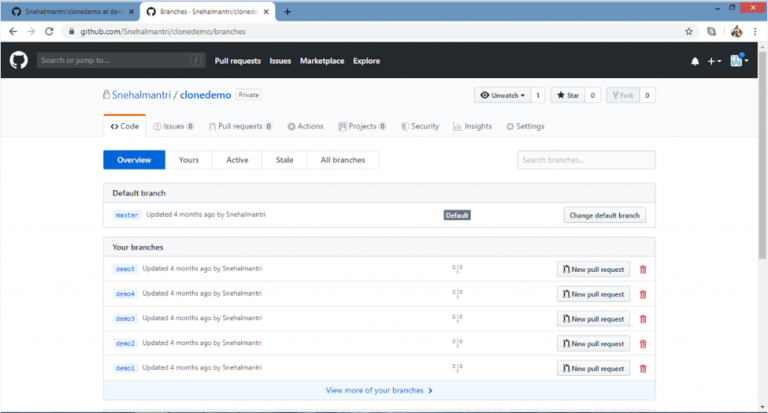
- #Git delete branch error not y merged how to
- #Git delete branch error not y merged update
- #Git delete branch error not y merged code
Usually what this means is that the baselines are what you’d expect as you work through a feature.

The only way that baselines change is when you or someone in your team accepts a change. That means as you make changes to your components, either by committing new code, merging other branches or otherwise, your baselines will follow your stories. How baselines are calculatedĪs stated above, Chromatic maintains an individual baseline for each story, at each viewport, for each commit. Bitbucket and GitLab will work out of the box. If you are using GitHub, you need to enable our GitHub App (on the Pull Requests screen) for this feature to work. When running the squash/rebase merge commit we’ll use the accepted baselines of the most recent commit on the head branch of the PR. Instead, we use Git provider APIs to detect this situation. This means Chromatic has no way to tell, using Git, that baselines accepted during the PR should “come over” to the main branch. If you use the “squash” or “rebase” merge feature on Pull Requests, then a commit is created on your base branch that is not a descendant of the commits for the PR. Your baselines are preserved between branches, even when squashing or rebasing wipes the Git history. For example:Ĭhromatic detects squash and rebase merges. You can bypass this with the -ignore-last-build-on-branch= flag of chromatic. Conceptually, that might mean that Chromatic should throw away any approvals that were made for builds on the branch, however this is probably not what you want.įor this reason, we always include accepted baselines from the latest build on the current branch, regardless of git history. If you rebase a branch (say updating to branch off the latest commit off main), then you create a new commit that isn’t a git descendent of the previous (pre-rebase) commit on that branch. In such situations, Chromatic will choose the most recent approved change as the baseline. When you merge two branches together, Chromatic can sometimes have two (or more) potential screenshots to use as the baseline (one from each branch). This means if your team is developing on multiple branches in parallel, changes to the approved component screenshots on one branch will not affect the others. When you are developing in a branch, it is natural that the baseline image should be chosen from previous commits on the branch. This means it is easy to see which builds belong to which branch of development, which components exist and are tested in which branch, and how a component has changed over the history of a branch. Learn how we calculate baselines » BranchesĬhromatic uses the branch that is checked out when you run a build to mark builds in our system.

When you merge that branch into another (for instance back into main), the baseline comes with it.
#Git delete branch error not y merged update
When you accept a snapshot you also update the baseline for that story on that branch. Each story has its own baseline that is tracked independently on each branch. The mechanism to achieve this is explained below.Ĭhromatic’s UI Tests compare snapshots to a baseline: the last known “good” state of the story. That means once a snapshot is accepted as a baseline, it won’t need to be re-accepted until it changes, even through git branching and merging. One way to think about it is as if we checked in a snapshot file into your repository every time you accept a change (we don’t do this but we aim to behave as if we did). UI Tests: tracking baselinesįor UI Tests, we aim to keep an up to date “baseline” for each story (at a given viewport) that lives alongside the git history.

Technically, to achieve that, we need to find the “merge-base build” to compare with.
#Git delete branch error not y merged code
This is similar to what systems like GitHub do when showing you the code changes in a PR. UI Review: comparing branchesįor UI Review, Chromatic’s aim is to show you what will change on the base branch when you merge this PR.Īs such, Chromatic will compare each story on the head branch with the way the story looked on the base branch when you branched off or last merged-in. However, there can be situations where things get confusing this document describes in detail the way Chromatic does it.

The way it works is intended to get out of your way and do what you expect.
#Git delete branch error not y merged how to
Branches and baselines Branches and baselinesĬhromatic uses your git history to decide how to check stories for changes for both UI Tests and UI Review.


 0 kommentar(er)
0 kommentar(er)
